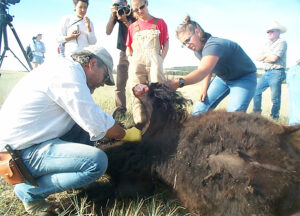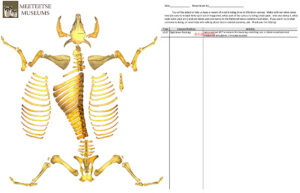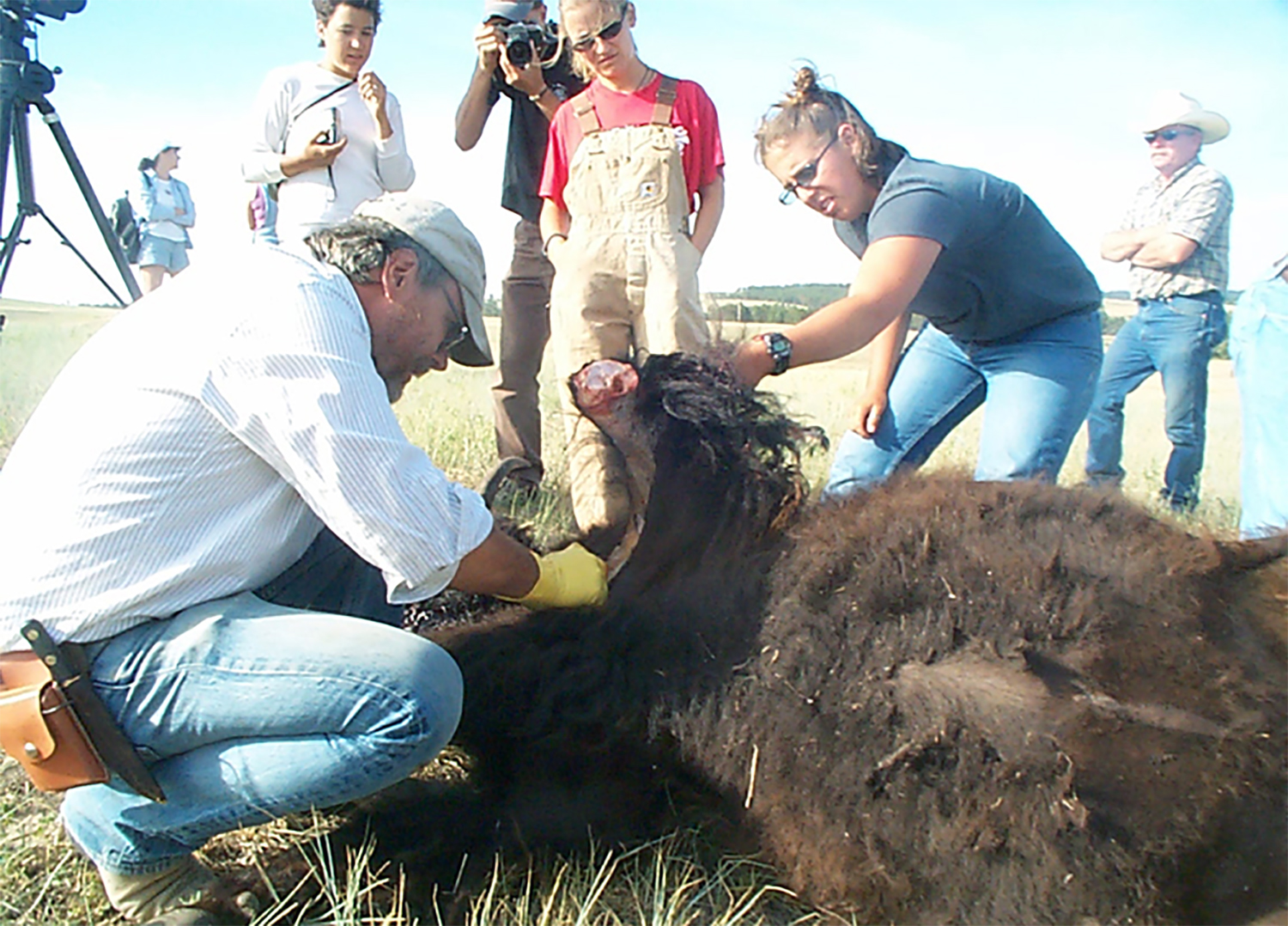Experimental Archaeology: Bison Butchery
By Dr. Lawrence Todd
One of archaeology’s central goals is to make reliable interpretations about past conditions based on the traces that survive today. This is difficult and requires a tremendous amount of time and effort spent trying to develop, evaluate, and refine archaeological interpretive methods. Finding artifacts and other clues from the past is the easy part – being able to apply well-researched methods to try to give meaning to the artifacts is the hard part, the part that puts the science into archaeological science.

Larry Todd butchers a bison with stone tools in Crawford, Nebraska 2002.
One way to work on improving interpretive methods is experimental archaeology, such as the bison butchery event being hosted by the Meeteetse Museums. Before talking about the experimental part in more detail, it’s important to distinguish between experiential learning and experimental archaeology. In the former, participants gain appreciation, skills, and impressions by doing something – like cutting up a dead animal with sharp rocks, or making a stone tool, or tanning a hide, or using an atlatl. It provides an opportunity for personal growth. In the later, data are collected that allow others to learn from and use the activity to work on building and tinkering with methods and interpretations. Done correctly, experimental archaeology is an important part of what’s known as middle range research (Binford 1978, 1981) in archaeology; middle range in that it serves as the link between observations to interpretations, between what we see and record and the stories we tell about what happened. Experimental archaeology seeks growth in the field of archaeology, rather than just for the person doing the activity.
What sorts of data should be collected when doing experimental archaeology? Trick question. The data collected through experimental archaeology depend on the archaeological research problems you are trying to address. Endless questions, data collection options abound. Three of the research topics that the Meeteetse Museum butchery event seeks data for include: 1) expanding the number of bones with stone tool induced cutmarks produced during controlled butchery events; 2) evaluating models of stone tool cutmark accumulation on bison bones from a well-preserved prehistoric winter campsite from northwestern Wyoming, and 3) expanding our understanding of the relationships between bison diet, mobility, life history and the isotopic and trace element data preserved archaeologically.
-

Sheets like this one will be used during the Museums’ bison butchering event on October 23rd to track cut marks.
Identifying Cutmarks. When archaeologists recover bones, we often spend a good deal of time looking at scratches, gouges, punctures, and abrasions. Which are cut marks? If they are cutmarks, were they made with a metal tool or a stone tool? Which were made be another animal stepping on the bone? Which are carnivore tooth marks? Which are old, which are recent? When we butcher the bison for this project only stone tools will be used so once the bones are cleaned there will be an unambiguous cause of the inflicted marks. These can then be studied by researcher interested in refining our understanding of stone tool cut mark characteristics. One of the researchers who has expressed an interest in coming to Meeteetse to use the bones from this experiment in his research, Dr. Erik Otárola-Castillo (Purdue),has contacted the Museum about incorporating the bones from the bison butchery event into his research program (McPherron et al. 2021; Otárola-Castillo et al. 2018) on identification and interpretation of marks on bone surfaces. These and many other studies (e.g., Pante et al. 2017) need the types of basic, control data sets that experimental archaeology can help provide. To make these data most useful, an experimental archaeology project needs to prepared to record specific data about what’s done.
-

These drawings illustrate the cutmarks on bison bones from a site in Sunlight Basin known as Bugas-Holding (48PA563).
Interpreting Cutmarks. If we can be relatively confident the grooves and scratches, we see on are cutmarks, we can begin tabulating the locations where these marks occur on bones from archaeological sites. When the locations of all marks on every identified bone from a site are illustrated on the places where they occur on an animal’s body, we have a rough “blueprint” of how the animal’s carcass was processed. We’ll be using an example of cutmark locations documented on bison bones from a site in the Sunlight Basin excavated by the University of Wyoming in the 1980s (Bugas-Holding). This site was rapidly buried and has remarkable bone preservation with most bone surfaces unweathered and retaining an exceptional record of the traces that human tool use left on the bones. During our experimental butchery experiment these cutmark locations will provide a basic blueprint for how we address the butchery. We’ll try to butcher the carcass in a way that might mimic the placement of slices and cuts on the archaeological specimens to better understand what the record on the bones from the site may be telling us about people’s goals and products being sought from the animal.
- Expanding Understanding Bison Biogeochemistry. Much of the work being done by the Meeteetse Museums in collaboration with Dr. Ken Cannon (Cannon Heritage Consultants) and Dr. Chris Widga (Gray Fossil Site and Museum, East Tennessee State University) involves study of bison bone and tooth chemistry to help reconstruct past bison ecology and environmental settings (Cannon 2007; Gadbury et al. 2000). At the heart of these studies is the oft heard saying “you are what you eat” in that the food and water that enters an animal’s system during its life can leave chemical records locked in the bones and teeth that can be recovered archaeologically (Widga et al. 2017). Documenting and studying these chemical signatures can provide useful and exciting information about past behaviors and environments. As with any interpretive tool, there is always room for improving our understanding of the underlying biological processes, and experimental archaeology can help with this. For the Meeteetse Museum bison butchery event this will entail collection of samples of both the forage the bison was eating and the water it was drinking. Once the carcass processing begins, we’ll be collecting samples to help track how these chemical signatures are altered as the pass through the animal’s biological system. We’ll collect stomach and intestine contents, blood samples, tissue samples, and hair samples as well as the more durable bones and teeth. Analysis of these samples, as well as any other life-history information about this specific animal such as age of death, number of pregnancies, any vaccinations or other introduced chemicals will be incorporated as part of the background data available for any future studies of the bones and teeth that will be curated in the Meeteetse Museums. As with all aspects of archaeology, the more contextual data associated with an item, the greater its long-term research potential.
Experimental archaeology is one of the ways we work to refine our abilities to make the highest fidelity interpretations of past events, actions, and processes possible. It helps develop methods and can provide control samples, it involves taking a lot more time and effort collecting information than you’d would be part of an experiential activity. As with every methods-related study, experimental archaeology helps us have more reliable answers to what should be the basic question asked anytime you hear someone make a statement about what the past was like – “how do you know that?”
Some additional Technical Readings:
Binford, L. R.
1978 Nunamiut Ethnoarchaeology. Academic Press, New York.
1981 Bones: Ancient Men and Modern Myths. Academic Press, New York.
Cannon, Kenneth P.
2007 “They Went as High as They Choose:” What an Isolated Skull Can Tell Us about the Biogeography of High-altitude Bison. Arctic, Antarctic, and Alpine Research 39(1):44-56.
Gadbury, C., L. Todd, A. H. Jahren, and R. Amundson
2000 Spatial and temporal variations in the isotopic composition of bison tooth enamel from the Early Holocene Hudson-Meng Bone Bed, Nebraska. Palaeogeography, Palaeoclimatology, Palaeoecology 157(1-2):79-93.
McPherron, Shannon P., Will Archer, Erik R. Otárola-Castillo, Melissa G. Torquato, and Trevor L. Keevil
2021 Machine learning, bootstrapping, null models, and why we are still not 100% sure which bone surface modifications were made by crocodiles. Journal of Human Evolution:103071.
Otárola-Castillo, Erik, Melissa G. Torquato, Hannah C. Hawkins, Emma James, Jacob A. Harris, Curtis W. Marean, Shannon P. McPherron, and Jessica C. Thompson
2018 Differentiating between cutting actions on bone using 3D geometric morphometrics and Bayesian analyses with implications to human evolution. Journal of Archaeological Science 89:56-67.
Pante, Michael C., Matthew V. Muttart, Trevor L. Keevil, Robert J. Blumenschine, Jackson K. Njau, and Stephen R. Merritt
2017 A new high-resolution 3-D quantitative method for identifying bone surface modifications with implications for the Early Stone Age archaeological record. Journal of Human Evolution 102:1-11.
Widga, C. C., J.D. Walker, and A. Boehm
2017 Variability in Bioavailable 87Sr/86Sr in the North American Midcontinent. Open Quaternary 3(4):1-7.


